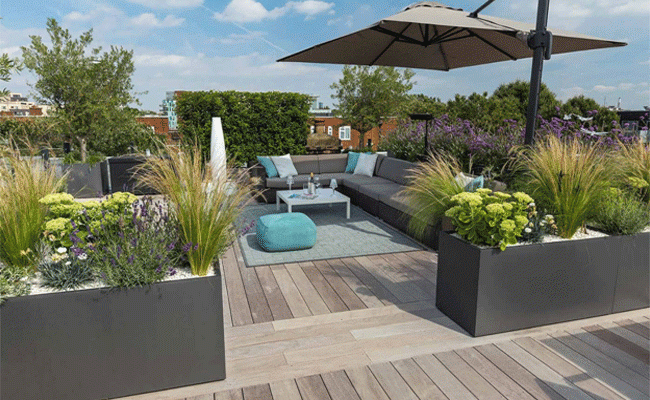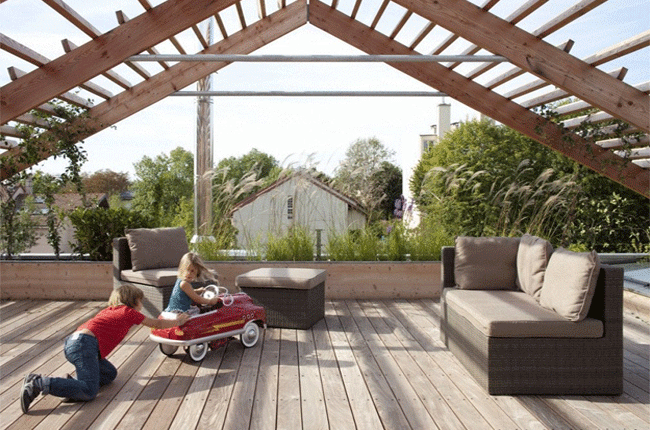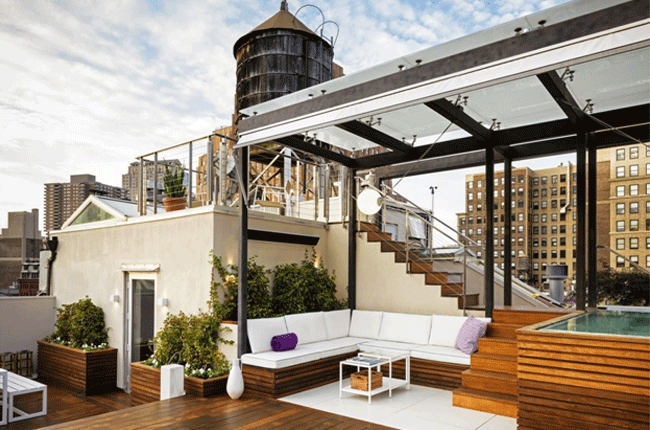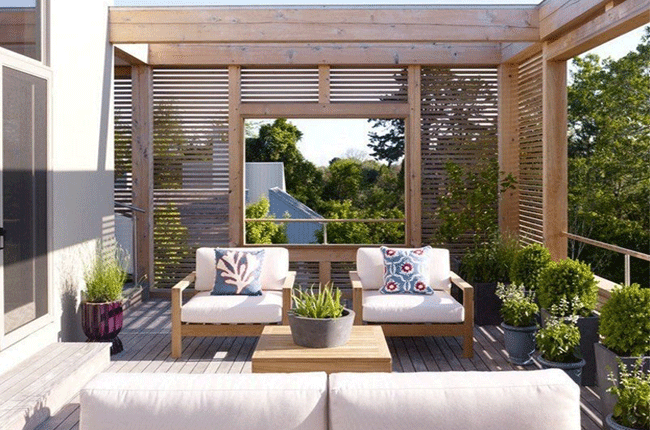
A rooftop deck can be an excellent addition to maximize your living space and enjoy the beautiful scenery in Boston, Massachusetts. With a rooftop deck, you can create an outdoor living space perfect for entertaining, relaxing, and taking in breathtaking city views.
In this blog post, we’ll explore
- The benefits of building a rooftop deck,
- We will discuss different decking materials and
- Rooftop Deck board options,
- Some creative rooftop deck design ideas
- Important considerations when planning a rooftop decking project
By the end of this post, you’ll better understand what it takes to create a beautiful and functional rooftop deck that elevates your Boston, Massachusetts, living experience.
Benefits of Building a Rooftop Deck
Adding a rooftop deck to your home can offer many benefits that significantly enhance your living experience. Here are some of the key advantages of building a rooftop deck:
- More outdoor living space: A rooftop deck adds a functional outdoor living area perfect for entertaining guests, relaxing with family, or enjoying city views.
- Better views: Rooftop decks provide a stunning, elevated view of the city skyline, ocean, or surrounding landscape.
- Increased property value: Rooftop decks increase overall property value, which is particularly useful in a competitive real estate market.
- Versatility: Rooftop decks you can design to serve many purposes, from outdoor kitchens and bars to cozy retreats for relaxation.
- Privacy: Rooftop decks can offer increased privacy depending on the location of your home, especially if you have neighbors overlooking your backyard or ground-level patio.
Choosing the Right Decking Material
When it comes to choosing the suitable decking material for your rooftop deck, there are several options available to you. Two popular options are pressure-treated wood and composite decking. Here’s a closer look at each option, including their Benefits and Maintainance:
Pressure Treated Wood
Thanks to its affordability and durability, pressure-treated wood is a popular choice for decking projects. This type of wood is treated with chemicals to make it resistant to rot, insects, and weather damage. It’s also readily available and can be cut and shaped to fit your design needs. Some of the pros and cons of pressure-treated wood include the following:
Benefits:
- Affordable
- Durable
- Widely available
- It can be cut and shaped easily
- Can be stained or painted to match your design preferences
Maintainance requirement:
- Requires regular maintenance, such as staining or sealing, to prevent weathering and warping
- It can be susceptible to cracking, splintering, and fading over time
- The chemicals used in the treatment process can be harmful to the environment and human health
Composite Decking
Composite decking is a newer alternative to traditional wood decking, becoming increasingly popular due to its low maintenance and long lifespan. It’s made of a blend of wood fibers and plastic, which makes it resistant to weather damage, insects, and rot. Composite decking comes in various colors and textures, giving you more design flexibility. Some of the pros and cons of composite decking include the following:
Benefits:
- Low maintenance
- Resistant to weather damage, insects, and rot
- Available in a variety of colors and textures
- Long lifespan
- Environmentally friendly
Maintainance requirement:
- More expensive than pressure-treated wood
- It can be prone to scratching and fading over time
- Not as easy to cut and shape as wood decking
- It may require special installation techniques and tools
Which Decking Material is Best for Your Rooftop Decking Project?
The choice of decking material ultimately depends on your specific project needs, design preferences, and budget. Pressure-treated wood is a good choice if you’re on a tight budget and are okay with the regular maintenance it requires. Composite decking, on the other hand, is an excellent choice if you’re looking for a low-maintenance, long-lasting solution that’s environmentally friendly. Consider your priorities and consult a professional decking contractor to help you decide which decking material suits your rooftop decking project.
Rooftop Deck Design Ideas
When designing a rooftop deck, plenty of creative and practical ideas can help you maximize your outdoor living space and create a beautiful and functional area. Here are a few rooftop deck design ideas to inspire you:
1. Incorporate an Outdoor Kitchen
If you love entertaining, consider adding an outdoor kitchen to your rooftop deck. You can include a grill, sink, refrigerator, and other kitchen amenities to create a functional and stylish space perfect for hosting outdoor dinners and parties.
2. Add a Fire Table or Fire Pit
Adding a fire table or fire pit to your rooftop deck is a great way to create a cozy and inviting atmosphere. You can choose from various styles and materials, including natural gas, propane, or wood-burning options.
3. Create a Lounge Area
Make your rooftop deck the ultimate relaxation spot by adding a lounge area. You can include comfortable seating, cushions, and outdoor rugs to create a cozy and inviting space to unwind and enjoy the views.
4. Incorporate Greenery
Adding plants and greenery to your rooftop deck can help create a natural and peaceful oasis in the city’s heart. You can choose from various plants, including small trees, shrubs, and potted plants, to create a beautiful, lush outdoor space.
5. Install Lighting
Adding lighting to your rooftop deck can help create a warm and inviting atmosphere and make the space more functional and safe to use at night. You can choose from various lighting options, including string lights, lanterns, and spotlights.
Decking Project Considerations
Planning a rooftop decking project requires careful consideration of several factors to ensure safety, stability, and compliance with city regulations. Here are some important considerations to keep in mind when planning a rooftop decking project:
- Obtain Permits and Follow Regulations
Before starting any rooftop decking project, it’s essential to check with your local city and obtain any necessary permits or approvals. City regulations may vary, but standard requirements include structural engineering plans, building code compliance, and fire safety considerations.
- Check for Power Lines
It’s essential to check for power lines or any other overhead obstacles before starting your project. This information can be obtained from your local utility company. If there are power lines, follow the required safety clearance requirements.
- Consider Weight Restrictions
Rooftop decks have weight restrictions that must be considered when planning your project. The weight of the decking material, furniture, and any other elements on the terrace should not exceed the weight limit of the building structure. It’s essential to have a structural engineer review your plans and ensure they meet safety standards.
- Ensure Safety and Stability
Safety and stability should be top priorities when building a rooftop deck. The deck should be securely anchored to the roof and include proper railings and safety features to prevent falls or accidents. Consider hiring a professional contractor experienced in building rooftop decks to ensure the project is done correctly and safely.
- Weather and Climate Considerations
It’s important to consider weather and climate conditions when planning a rooftop deck project. Strong winds, snow loads, and rain accumulation can impact your deck’s design, materials, and overall structure. Consult a professional to ensure your design and materials suit your specific climate and weather conditions.
Choosing the Right Decking Boards
Choosing the right decking boards is essential to building a successful rooftop deck. Several different types of panels are available, each with pros and cons. Here are some of the most common decking boards available:
- Pressure Treated Wood
Pressure-treated wood is a popular decking material due to its affordability and durability. It is chemically treated to resist rot, decay, and insect damage. However, it requires regular maintenance, such as sealing or staining, to maintain its appearance and durability.
- Composite Decking
Composite decking is made from a combination of plastic and wood fibers. It is a low-maintenance, long-lasting option resistant to fading, staining, and mold growth. It comes in various colors and finishes to fit any design aesthetic. However, it is more expensive than pressure-treated wood and may have a different natural look and feel.

- Rooftop Decking Boards
There are also decking boards designed explicitly for rooftop decks. These boards are lightweight and easy to install, making them ideal for rooftop installations. They are typically made of aluminum or composite materials and come in various finishes and colors.
Conclusion
Overall, a well-planned rooftop decking project can transform your flat-roofed building into an outdoor oasis you and your family can enjoy for years. So start exploring deck design ideas and decking material options to create the perfect rooftop deck for your Boston, Massachusetts, home.


Leave a Reply